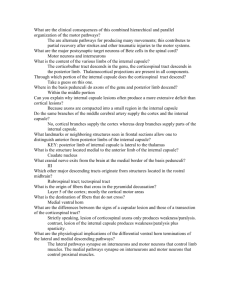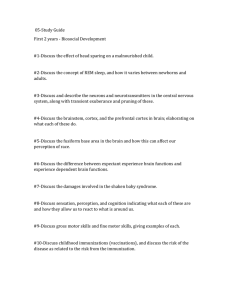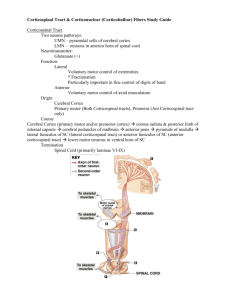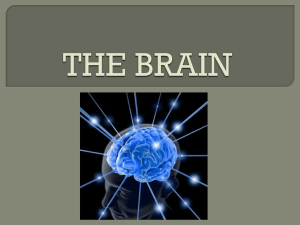To learn the functional organization of the corticospinal tract (the
advertisement
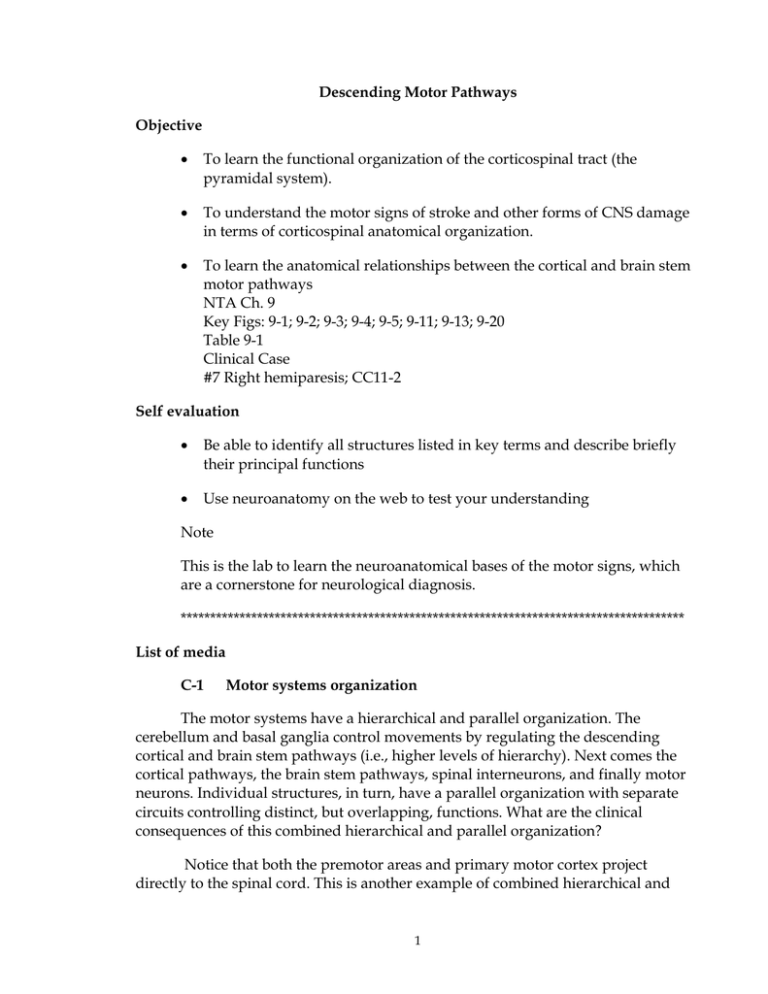
Descending Motor Pathways Objective To learn the functional organization of the corticospinal tract (the pyramidal system). To understand the motor signs of stroke and other forms of CNS damage in terms of corticospinal anatomical organization. To learn the anatomical relationships between the cortical and brain stem motor pathways NTA Ch. 9 Key Figs: 9-1; 9-2; 9-3; 9-4; 9-5; 9-11; 9-13; 9-20 Table 9-1 Clinical Case #7 Right hemiparesis; CC11-2 Self evaluation Be able to identify all structures listed in key terms and describe briefly their principal functions Use neuroanatomy on the web to test your understanding Note This is the lab to learn the neuroanatomical bases of the motor signs, which are a cornerstone for neurological diagnosis. ************************************************************************************** List of media C-1 Motor systems organization The motor systems have a hierarchical and parallel organization. The cerebellum and basal ganglia control movements by regulating the descending cortical and brain stem pathways (i.e., higher levels of hierarchy). Next comes the cortical pathways, the brain stem pathways, spinal interneurons, and finally motor neurons. Individual structures, in turn, have a parallel organization with separate circuits controlling distinct, but overlapping, functions. What are the clinical consequences of this combined hierarchical and parallel organization? Notice that both the premotor areas and primary motor cortex project directly to the spinal cord. This is another example of combined hierarchical and 1 parallel control. Premotor areas both regulate the primary motor cortex (i.e., hierarchical) and spinal neurons (i.e., parallel). C-2 Motor organization of the spinal cord An important principle governing the organization of the motor systems is that there are separate motor paths for controlling limb muscles (especially distal muscles serving the hand or foot) and axial/proximal muscles. Identifying the locations of motor neurons innervating these different sets of muscles provides a framework of understanding this dual organization. Limb motor neurons are located in the lateral portion of the ventral horn and, in turn, receive their descending control primarily from pathways in the lateral column of the white matter, especially the lateral corticospinal tract. Axial and proximal motor neurons are located in the medial portion of the ventral. These neurons receive their descending control from pathways in the medial white matter (termed the ventral column). Two important medial descending pathways are the ventral corticospinal tract and the lateral vestibulospinal tract. C-3 Frontal Motor Areas Cytoarchitectonic area 4, the primary motor cortex, is located in the precentral gyrus. This area is important in the execution of movments. Area 4 lesions produce weakness. Area 6 is a premotor region that includes several somatotopically organized components. One of these is the supplementary motor area (SMA) located in the most dorsomedial part of area 6. This area is thought to play a role in the planning of complex sequences of movements that involve the coordinated use of both limbs, especially the distal extremity. The lateral portion of area 6 is also a premotor region, and is often simply referred to as the premotor cortex. A-16 Section through the pre- and postcentral gyri - Nissl stain for cell bodies. Identify the central sulcus on this slide (the prominent sulcus running diagonally). The motor cortex is located on the precentral gyrus. The portions of the precentral gyrus that lie within the central sulcus and the exposed surface are the regions that contain the very large pyramidal cells (called Betz cells) in layer V. While the boundaries are approximate, identify layers I, V, and VI in the motor cortex. What are the major postsynaptic target neurons of Betz cells in the spinal cord? primarmotor Primary motor cortex (movie) 2 Note that the corticospinal tracts originate from the territory containing the arm, trunk, and leg representations, while the corticobulbar tract originates from the facial area. Key: Face=green (this corresponds to the origin of the corticobulbar tract) Arm=yellow Trunk=purple Leg=aqua 3 pyramstem Pyramidal system (movie) Key: Descending motor cortical projection=blue (left cortex), gray (right cortex) X-120 Horizontal section through the thalamus Identify the anterior limb, genu, and posterior limb of the internal capsule. Use your brain stem model and identify the approximate level of this section. What is the content of the various limbs of the internal capsule? Through which portion of the internal capsule does the corticospinal tract descend? Where in the basis pedunculi do axons of the genu and posterior limb descend? Thrombosis or hemorrhage involving which branches of the middle cerebral artery are the most common causes of lesions in this area? Capsular infarcts commonly cause a total hemiparesis including the face. Can you explain why such a massive deficit is more rarely seen after cortical lesions? Do the same branches of the middle cerebral artery supply the cortex and the internal capsule? What landmarks or neighboring structures seen in frontal sections allow one to distinguish anterior from posterior limbs of the internal capsule? M-2 Horizontal—internal capsule and thalamus (MRI) On the brain stem model, determine the approximate imaging plane. In this scan the white matter of the cerebral hemisphere appears darker than gray matter and CSF appears white. On the scan, identify the three main components of the internal capsule: anterior limb, genu, and posterior limb. Also identify the caudate nucleus, putamen, thalamus, third ventricle, and components of the lateral ventricles (anterior and posterior horns). What portion of the corpus callosum is present in this image? X-75 Coronal sections through internal capsule This is a coronal section at the level of the basal ganglia and thalamus that shows the course of the internal capsule. The internal capsule is located medial to the globus pallidus and putamen, and lateral to the thalamus, near the third ventricle. This section slices through the posterior limb of the capsule, which contains corticospinal fibers, thalamic radiation, and corticovestibular, corticorubral, and corticoreticular fibers. This section is through the ventral lateral nucleus. Neurons in this thalamic nucleus receive somatic sensory information and input from the deep cerebellar nuclei and project to the primary motor cortex and premotor cortex (lateral area 6). 4 X-70 Coronal sections through internal capsule This section cuts through the ventral posterior nucleus, which is the somatic sensory relay nucleus. It is located caudal to the ventral lateral nucleus. This section also cuts through the magnocellular division of the red nucleus, from which the rubrospinal tract originates. M-5 Coronal—cerebral hemisphere and diencephalon; horizontal (longitudinal)—brain stem (MRI) Before examining the scan, determine the approximate imaging plane on the brain stem model. Note that the imaging plane is approximately orthogonal to the one on slide M003. Identify the internal capsule, which does not appear as dark as it does in slide M002. As a consequence the borders of the internal capsule are difficult to distinguish from the surrounding structures. Which limb of the internal capsule is shown in the scan? What is the structure located medial to the internal capsule? Identify the red nuclei, which, as in slide M003, appears dark. X-45 Section through the midbrain This is a section of the midbrain at the level of the red nucleus. The corticospinal tracts condense from the internal capsule to form the basis pedunculi, at this level below the colliculi. Corticospinal and corticobulbar fibers are located in the intermediate portion of the basis pedunculi, and within this portion, they are organized somatotopically: the most lateral fibers are related to the lower extremity, the most medial to the face and larynx, and the intermediate fibers to the upper extremity. What cranial nerve exits from the brain at the medial border of the basis pedunculi? Which other major descending tracts take origin from structures shown in this slide? M-3 Horizontal—cerebral hemisphere; transverse—through the midbrain (MRI) On the brain stem model, determine the approximate imaging plane. In general, white matter appears darker than gray matter as in slide M002. However, the red nucleus also appears dark because of the presence of ferritin, an ironcontaining substance that affects the MRI signal. Identify the major brain divisions that are present in the scan: cerebral hemispheres, midbrain, and cerebellum. In the midbrain, identify the tectum, the tegmentum, and the base (basis pedunculi). Identify the following structures that are involved in control of limb movement: red nuclei, basis pedunculi (also termed crus cerebri), and the substantia nigra. 5 (Myelinated axons of the superior cerebellar peduncle course to and through the red nucleus.) The periaqueductal gray matter and tectum (superior colliculus) are also apparent in the scan. X-100 Descending cortical fibers through brain stem Descending cortical fibers can be seen to form a compact bundle in the caudal pons. These fibers form the pyramid, which is located in the medulla. The red nucleus is cut in the sagittal section. It is encapsulated by axons emerging from the cerebellum (see cerebellar laboratory). The rostral portion of the red nucleus is the parvocellular division; the caudal portion, the magnocellar division C-5 Parasagittal section through the brain stem and cerebellum following injection of wheat germ agglutinin conjugated with HRP (HRPWGA) in red nucleus This section cuts through the brain stem and cerebellum of the cat. A tracer was injected into the red nucleus on the other side of the brain stem. The tracer was taken up by neurons in the red nucleus and transported anterogradely along the rubrospinal tract. We see the fibers after they cross the midline. Terminals from the deep cerebellar nuclei that are located in the red nucleus also take up tracer, but transport it back to their cell bodies in the cerebellum (retrograde transport). Here too, we see labeling in the axons and cell bodies contralateral to the side of the injection. The neuronal cell bodies are located in the interposed nuclei. (Slide courtesy of Dr. Alan Gibson, Barrow Neurological Institute.) X-37 Descending cortical fibers in the rostral pons In this section the descending cortical fibers are broadly distributed. More caudally, we will see that they re-group and form discrete bundles. These descending cortical fibers form the pyramid. X-30 Descending cortical fibers in the caudal pons The corticospinal and corticobulbar are located in the ventral pons. The Pontine reticulospinal tract arises from portions of the reticular formation. X-20 Descending cortical fibers in the mid-medulla Identify the pyramids and the vestibular nuclei. The medial and lateral vestibulospinal tracts originate from the vestibular nuclei. The medullary reticulospinal tract arise from portions of the reticular formation. F-1 Ventral surface of brain stem and exiting cranial nerves 6 Identify the pyramidal decussation. What is the origin of fibers that cross in the decussation? What is the destination of fibers that do not cross? X-10 Spinal cord - medulla juncture and decussation of pyramidal tract This slide is a transverse section at the level of the decussation of the corticospinal axons in the medullary pyramids. In humans, damage to this area is usually bilateral (bilateral corticospinal tract signs with sparing of the face and bilateral XIIth nerve palsy), because the blood supply from the anterior spinal artery is distributed bilaterally and because compression from tumors in this area is also exerted bilaterally. What are the differences between the signs of a capsular lesion and those of a transection of the corticospinal tract? C-7 Schematic diagram of different descending tracts in spinal cord This is a schematic diagram of the major descending supraspinal tracts in the spinal cord. Note that the lateral corticospinal and rubrospinal tracts are located in the lateral column. The vestibulospinal and reticulospinal tracts, which are located more anteriorly (ventrally), are adjacent to the ventral corticospinal tract. It is known from studies of terminal degeneration that this separation extends to the location of the terminals of these axons in the gray matter of the cord. What are the physiological implications of this physiological arrangement? 7 X-5 Spinal cord - myelin stain Identify the dorsal horn, intermediate zone, and ventral horn and the three major white matter columns (dorsal, lateral, and ventral). What are the differences in the size and proportions of these component parts of the spinal cord as a function of rostro-caudal position? Be sure to be able to identify the level of each of the spinal cord sections shown on this slide. Identify the medial and lateral motor nuclei. What are the differences in the inputs and projections of the nuclei. What are their rostro-caudal distributions? X-15 Caudal medulla - myelin stain This is a section through the medulla, from a normal individual. Identify the pyramidal tract. C-9 Caudal medulla and spinal cord following capsular infarct This is a myelin-stained section through the caudal medulla. There is a complete absence of staining in the location of the pyramidal tract on one side. The actual cell damage occurred in a more rostral location of the brain, probably due to infarction of a branch of the middle cerebral artery supplying the internal capsule. Since the tract is damaged above the medullary pyramids, the motor deficit will be on the contralateral side. C-10 Caudal medulla and spinal cord following capsular infarct This is a section of the spinal cord from the patient shown in C-9. Note that the lateral corticospinal tract on the side opposite the lesion is lacking myelin stain. The ventral corticospinal tract on the same side as the lesion also shows complete absence of staining. 8 Key Structures and Terms Motor cortex Supplementary motor cortex Premotor cortex Layer V neurons Red nucleus Parvocellular division Magnocellular division Superior colliculus Vestibular nuclei Pontine nuclei Reticular formation Ventral lateral and ventral anterior nuclei FIBER TRACTS AND BUNDLES: Corticospinal: ventral and lateral Corticobulbar Internal capsule Basis pedunculi Topographic organization Pyramid and decussation Lateral column Ventral column Rubrospinal tract Vestibulospinal tracts Reticulospinal tracts Tectospinal tract 9 10
